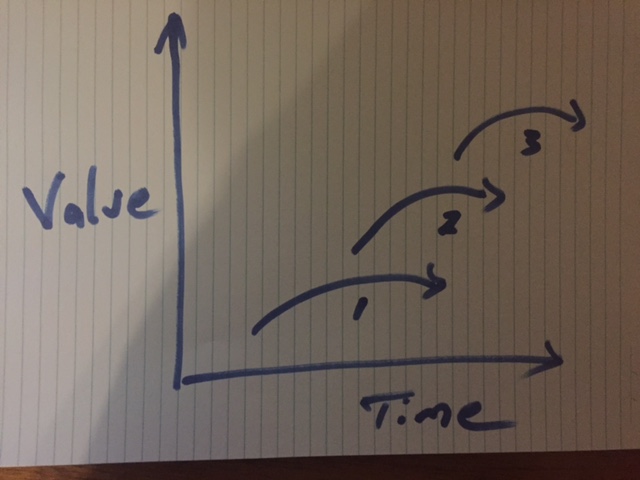What is the Three Horizons Framework?
In 1999, the book — The Alchemy of Growth was published.
It’s authors Mehrdad Baghai, Stephen Coley and David Clark studied a number of high growth organisations and as a result developed The Three Horizons Framework.
Since that time this simple, insightful framework has been used by countless corporate leaders.
As the name implies, The Three Horizons consists of 3 curves:
According to Stephen Coley:
‘Horizon one represents those core businesses most readily identified with the company name and those that provide the greatest profits and cash flow. Here the focus is on improving performance to maximize the remaining value.
Horizon two encompasses emerging opportunities, including rising entrepreneurial ventures likely to generate substantial profits in the future but that could require considerable investment.
Horizon three contains ideas for profitable growth down the road—for instance, small ventures such as research projects, pilot programs, or minority stakes in new businesses’
Although the ‘horizontal axis is time’ the framework does not suggest that the growth opportunities should be planned and implemented over a number of years.
In fact, the goal is to consider each of the opportunities concurrently.
This might mean for example that leaders might invest 70% of their resources in Horizon 1, 20% in Horizon 2 and 10% in Horizon 3.
The Three Horizons framework has a number of advantages:
– It’s a simple visual tool
– The framework encourages leaders to think of more than just the current business.
– It recognises that the industry and marketplace can change and also competitors could make inroads so whilst the current business might be in good shape this may not always be the case (Think Kodak for example)
– The model suggests that leaders will need to consider different ways to think about the various growth opportunities, risks and resources.
– The other advantage is that it helps leaders to adopt more of an innovation and growth portfolio approach.
The 100x Innovation System developed by Dr Ken Hudson has been heavily influenced by The Three Horizons and shares several of its features.
For example:
– The 100x System has 3 types of innovation – 1x, 10x and 100x.
– This system encourages leader to think of these 3 types of innovation concurrently and from a portfolio perspective.
– It also empowers leaders to think in a different way about 1x, 10x and 100x growth opportunities.
But there are a number of differences:
– The 100x Innovation System has Business and Personal Growth as the two dimensions rather than Value and time.
– The 100x uses an exponential innovation and growth curve
– And lastly, the 100x approach uses a single curve to suggest that each of the 3 types are connected and interdependent.
The leadership challenge is to boost a 1x Innovation into a 10x and 100x.
But regardless of which framework is used the goal is always to have more people, being more innovative, more often.

